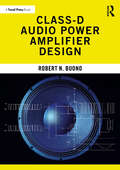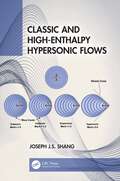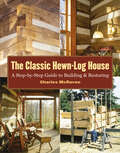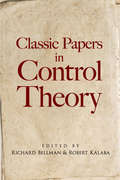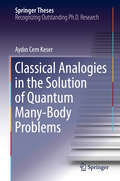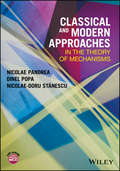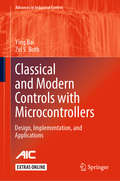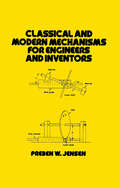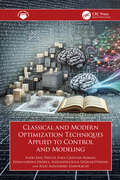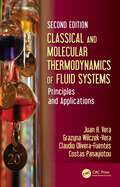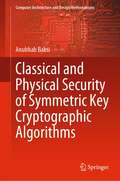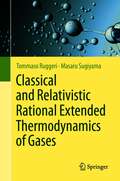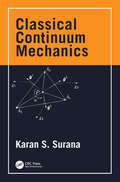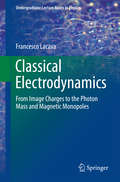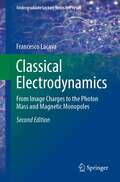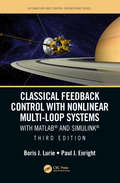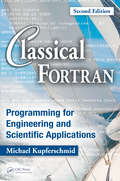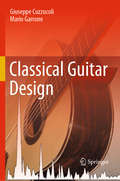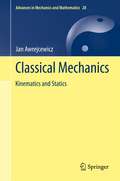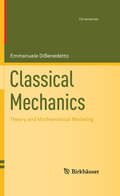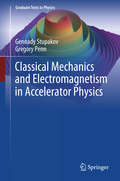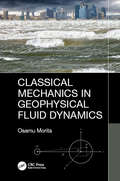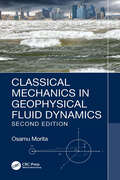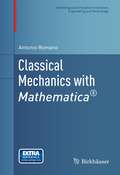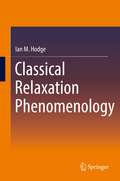- Table View
- List View
Class-D Audio Power Amplifier Design
by Robert N. BuonoClass-D Audio Power Amplifier Design is a comprehensive and detailed guide to Class-D amplifiers. Including historical perspectives covering the evolution of Class-D to the present day, this book provides a detailed discussion of each Class-D functional block.With design guidance to optimize performance, the reader will learn from a series of real-life examples and design challenges to equip them in designing reliable, high-performance Class-D audio amplifiers. Featuring numerous diagrams and schematics to aid learning, chapters also cover a wide range of topics, such as: Power supply considerations EMI mitigation Multi-channel designs Gate driver circuits L-C demodulation filters. Class-D Audio Power Amplifier Design is the essential reference guide for students, researchers, and professionals engaged with audio electronics.
Classic and High-Enthalpy Hypersonic Flows
by Joseph J.S. ShangClassic and High-Enthalpy Hypersonic Flows presents a complete look at high-enthalpy hypersonic flow from a review of classic theories to a discussion of future advances centering around the Born-Oppenheim approximation, potential energy surface, and critical point for transition. The state-of-the-art hypersonic flows are defined by a seamless integration of the classic gas dynamic kinetics with nonequilibrium chemical kinetics, quantum transitions, and radiative heat transfer. The book is intended for graduate students studying advanced aerodynamics and taking courses in hypersonic flow. It can also serve as a professional reference for practicing aerospace and mechanical engineers of high-speed aerospace vehicles and propulsion system research, design, and evaluation. Features Presents a comprehensive review of classic hypersonic flow from the Newtonian theory to blast wave analogue. Introduces nonequilibrium chemical kinetics to gas dynamics for hypersonic flows in the high-enthalpy state. Integrates quantum mechanics to high-enthalpy hypersonic flows including dissociation and ionization. Covers the complete heat transfer process with radiative energy transfer for thermal protection of earth reentry vehicle. Develops and verifies the interdisciplinary governing equations for understanding and analyzing realistic hypersonic flows.
The Classic Hewn-Log House: A Step-by-Step Guide to Building and Restoring
by Charles McRavenA classic of early American architecture, the hewn-log house has a unique rustic charm and character. In this engaging and informative guide, Charles McRaven provides illustrated step-by-step instructions that cover every aspect of building your own log house, from selecting the site and hewing the first log to laying the final chimney stone. Whether you’re building a new house or restoring an old one, McRaven offers proven techniques and time-tested advice that will help you successfully create a warm and inviting hewn-log home.
Classic Papers in Control Theory (Dover Books on Engineering)
by Richard Bellman Robert KalabaThis collection of historically and technically important papers follows a logical line of development from early work in mathematical control theory to studies in adaptive control processes. The book touches upon all the major themes: stability theory, feedback control, time lag, prediction theory, dynamic programming, "bang-bang" control, and maximum principles. The book opens with J. C. Maxwell's "On Governors" and continues with "The Control of an Elastic Fluid" by H. Bateman; an essay by editors Bellman and Kalaba, "The Work of Lyapunov and Poincaré"; Hurwitz's "On the Conditions Under Which an Equation Has Only Roots With Negative Real Parts"; Nyquist's "Regeneration Theory"; "Feedback — The History of an Idea" by H. W. Bode; a paper on forced oscillations in a circuit by B. van der Pol; "Self-excited Oscillations in Dynamical Systems Possessing Retarded Action" by N. Minorsky; "An Extension of Wiener's Theory of Prediction" by Zadeh and Ragazzini; "Time Optimal Control Systems" by J. P. LaSalle; "On the Theory of Optimal Processes" by Boltyanskii, Gamkrelidze, and Pontryagin; Bellman's "On the Application of the Theory of Dynamic Programming to the Study of Control Processes"; and the editors' study "Dynamic Programming and Adaptive Processes: Mathematical Foundation." Each paper is introduced with a brief account of its significance and with some suggestions for further reading.
Classical Analogies in the Solution of Quantum Many-Body Problems (Springer Theses)
by Aydın Cem KeserThis book addresses problems in three main developments in modern condensed matter physics– namely topological superconductivity, many-body localization and strongly interacting condensates/superfluids–by employing fruitful analogies from classical mechanics. This strategy has led to tangible results, firstly in superconducting nanowires: the density of states, a smoking gun for the long sought Majorana zero mode is calculated effortlessly by mapping the problem to a textbook-level classical point particle problem. Secondly, in localization theory even the simplest toy models that exhibit many-body localization are mathematically cumbersome and results rely on simulations that are limited by computational power. In this book an alternative viewpoint is developed by describing many-body localization in terms of quantum rotors that have incommensurate rotation frequencies, an exactly solvable system. Finally, the fluctuations in a strongly interacting Bose condensate and superfluid, a notoriously difficult system to analyze from first principles, are shown to mimic stochastic fluctuations of space-time due to quantum fields. This analogy not only allows for the computation of physical properties of the fluctuations in an elegant way, it sheds light on the nature of space-time. The book will be a valuable contribution for its unifying style that illuminates conceptually challenging developments in condensed matter physics and its use of elegant mathematical models in addition to producing new and concrete results.
Classical and Modern Approaches in the Theory of Mechanisms
by Dinel Popa Nicolae Pandrea Nicolae-Doru StanescuClassical and Modern Approaches in the Theory of Mechanisms is a study of mechanisms in the broadest sense, covering the theoretical background of mechanisms, their structures and components, the planar and spatial analysis of mechanisms, motion transmission, and technical approaches to kinematics, mechanical systems, and machine dynamics. In addition to classical approaches, the book presents two new methods: the analytic-assisted method using Turbo Pascal calculation programs, and the graphic-assisted method, outlining the steps required for the development of graphic constructions using AutoCAD; the applications of these methods are illustrated with examples. Aimed at students of mechanical engineering, and engineers designing and developing mechanisms in their own fields, this book provides a useful overview of classical theories, and modern approaches to the practical and creative application of mechanisms, in seeking solutions to increasingly complex problems.
Classical and Modern Controls with Microcontrollers: Design, Implementation And Applications (Advances in Industrial Control)
by Ying Bai Zvi S. RothThis book focuses on the design, implementation and applications of embedded systems and advanced industrial controls with microcontrollers. It combines classical and modern control theories as well as practical control programming codes to help readers learn control techniques easily and effectively. The book covers both linear and nonlinear control techniques to help readers understand modern control strategies. The author provides a detailed description of the practical considerations and applications in linear and nonlinear control systems. They concentrate on the ARM® Cortex®-M4 MCU system built by Texas Instruments™ called TM4C123GXL, in which two ARM® Cortex®-M4 MCUs, TM4C123GH6PM, are utilized. In order to help the reader develop and build application control software for a specified microcontroller unit. Readers can quickly develop and build their applications by using sample project codes provided in the book to access specified peripherals. The book enables readers to transfer from one interfacing protocol to another, even if they only have basic and fundamental understanding and basic knowledge of one interfacing function. Classical and Modern Controls with Microcontrollers is a powerful source of information for control and systems engineers looking to expand their programming knowledge of C, and of applications of embedded systems with microcontrollers. The book is a textbook for college students majored in CE, EE and ISE to learn and study classical and modern control technologies. The book can also be adopted as a reference book for professional programmers working in modern control fields or related to intelligent controls and embedded computing and applications. Advances in Industrial Control reports and encourages the transfer of technology in control engineering. The rapid development of control technology has an impact on all areas of the control discipline. The series offers an opportunity for researchers to present an extended exposition of new work in all aspects of industrial control.
Classical and Modern Mechanisms for Engineers and Inventors (Dekker Mechanical Engineering Ser. #75)
by JensenJensen (mechanical engineering, Mankato State U., Minn.) is a prolific designer/interpreter/reporter of mechanisms for the user of mechanical movements. This collection offers solutions or inspirations in some 20 areas including the slider crank, cycloid, screw and clamping mechanisms, antibacklash
Classical and Modern Optimization Techniques Applied to Control and Modeling
by Radu-Emil Precup Raul-Cristian Roman Elena-Lorena Hedrea Alexandra-Iulia Szedlak-Stinean Iuliu Alexandru ZamfiracheThe book presents a detailed and unified treatment of the theory and applications of optimization applied to control and modeling, focusing on nature-inspired optimization algorithms to optimally tune the parameters of linear and nonlinear controllers and models, with emphasis on tower crane systems and other representative applications.Classical and Modern Optimization Techniques Applied to Control and Modeling combines classical and modern approaches to optimization, based on the authors’ experience in the field, and presents in a unified structure the essential aspects of optimization in control and modeling from a control engineer’s point of view. It covers linear and nonlinear controllers, and neural networks based on reinforcement learning are considered and analyzed because of the need to reduce the complexity of the controllers and their design so that they can be practical to implement as low-cost automation solutions. The chapters are designed to quickly make the concepts of optimization, control, reinforcement learning, and neural networks understandable to readers with limited experience.This book is intended for a broad audience, including undergraduate and graduate students, engineers (designers, practitioners, and researchers), and anyone facing challenging control problems.
Classical and Molecular Thermodynamics of Fluid Systems: Principles and Applications
by Juan H. Vera Grazyna Wilczek-Vera Claudio Olivera-Fuentes Costas PanayiotouThis text explores the connections between different thermodynamic subjects related to fluid systems. In an innovative way, it covers the subject from first principles to the state of the art in fundamental and applied topics. Using simple nomenclature and algebra, it clarifies concepts by returning to the conceptual foundation of thermodynamics. The structural elements of classical and molecular thermodynamics of fluid systems presented cover, via examples and references, both the usefulness and the limitations of thermodynamics for the treatment of practical problems. This new edition explores recent advances in statistical associated fluid theories and contains creative end‑of‑chapter problems connecting the theory with real‑life situations. It includes new chapters on thermodynamics of polymer solutions and molecular thermodynamics and also presents advances in the study of the activity of individual ions. Provides a concise structure of concepts, using simple nomenclature and algebra Clarifies problems usually overlooked by standard texts Features end‑of‑chapter problems to enhance the reader’s understanding of the concepts Includes diverse topics of interest to researchers and advanced students, including elements of statistical thermodynamics, models of solutions, statistical associated fluid theory and the activity of individual ions Offers four appendices giving step‑by‑step procedures and parameters for direct use of the PRSV equation of state and the ASOG‑KT group method for fugacity and activity coefficient calculations Features a complete set of solutions to problems throughout the book, available for download on the book’s webpage under "Support Material" This textbook is written for advanced undergraduate and graduate students studying chemical engineering and chemistry as well as for practicing engineers and researchers.
Classical and Physical Security of Symmetric Key Cryptographic Algorithms (Computer Architecture and Design Methodologies)
by Anubhab BaksiThis book consolidates several key aspects from the state-of-the-art research in symmetric key cryptography, which is among the cornerstones of digital security. It presents the content in an informative yet beginner-friendly, accompanied with toy examples and comprehensible graphics. In particular, it highlights the recent developments in tool-assisted analysis of ciphers. Furthermore, promising device-dependent attacks, such as fault attack and side channel attacks on symmetric key ciphers, are discussed in detail. One salient feature of this book is to present a detailed analysis of various fault countermeasures. The coverage of our book is quite diverse—it ranges from prerequisite information, latest research contribution as well as future research directions. It caters to students and researchers working in the field of cryptography.
Classical and Relativistic Rational Extended Thermodynamics of Gases
by Tommaso Ruggeri Masaru SugiyamaRational extended thermodynamics (RET) is the theory that is applicable to nonequilibrium phenomena out of local equilibrium. It is expressed by the hyperbolic system of field equations with local constitutive equations and is strictly related to the kinetic theory with the closure method of the hierarchies of moment equations. The book intends to present, in a systematic way, new results obtained by RET of gases in both classical and relativistic cases, and it is a natural continuation of the book "Rational Extended Thermodynamics beyond the Monatomic Gas" by the same authors published in 2015. However, this book addresses much wider topics than those of the previous book. Its contents are as follows: RET of rarefied monatomic gases and of polyatomic gases; a simplified RET theory with 6 fields being valid far from equilibrium; RET where both molecular rotational and vibrational modes exist; mixture of gases with multi-temperature. The theory is applied to several typical topics (sound waves, shock waves, etc.) and is compared with experimental data. From a mathematical point of view, RET can be regarded as a theory of hyperbolic symmetric systems, of which it is possible to conduct a qualitative analysis. The book represents a valuable resource for applied mathematicians, physicists, and engineers, offering powerful models for many potential applications such as reentering satellites into the atmosphere, semiconductors, and nanoscale phenomena.
Classical Continuum Mechanics (Applied and Computational Mechanics)
by Karan S. SuranaThis book provides physical and mathematical foundation as well as complete derivation of the mathematical descriptions and constitutive theories for deformation of solid and fluent continua, both compressible and incompressible with clear distinction between Lagrangian and Eulerian descriptions as well as co- and contra-variant bases. Definitions of co- and contra-variant tensors and tensor calculus are introduced using curvilinear frame and then specialized for Cartesian frame. Both Galilean and non-Galilean coordinate transformations are presented and used in establishing objective tensors and objective rates. Convected time derivatives are derived using the conventional approach as well as non-Galilean transformation and their significance is illustrated in finite deformation of solid continua as well as in the case of fluent continua. Constitutive theories are derived using entropy inequality and representation theorem. Decomposition of total deformation for solid and fluent continua into volumetric and distortional deformation is essential in providing a sound, general and rigorous framework for deriving constitutive theories. Energy methods and the principle of virtual work are demonstrated to be a small isolated subset of the calculus of variations. Differential form of the mathematical models and calculus of variations preclude energy methods and the principle of virtual work. The material in this book is developed from fundamental concepts at very basic level with gradual progression to advanced topics. This book contains core scientific knowledge associated with mathematical concepts and theories for deforming continuous matter to prepare graduate students for fundamental and basic research in engineering and sciences. The book presents detailed and consistent derivations with clarity and is ideal for self-study.
Classical Electrodynamics: From Image Charges to the Photon Mass and Magnetic Monopoles (Undergraduate Lecture Notes in Physics)
by Francesco LacavaThis book proposes intriguing arguments that will enable students to achieve a deeper understanding of electromagnetism, while also presenting a number of classical methods for solving difficult problems. Two chapters are devoted to relativistic electrodynamics, covering all aspects needed for a full comprehension of the nature of electric and magnetic fields and, subsequently, electrodynamics. Each of the two final chapters examines a selected experimental issue, introducing students to the work involved in actually proving a law or theory. Classical books on electricity and magnetism are mentioned in many references, helping to familiarize students with books that they will encounter in their further studies. Various problems are presented, together with their worked-out solutions. The book is based on notes from special lectures delivered by the author to students during the second year of a BSc course in Physics, but the subject matter may also be of interest to senior physicists, as many of the themes covered are completely ignored or touched only briefly in standard textbooks.
Classical Electrodynamics: From Image Charges to the Photon Mass and Magnetic Monopoles (Undergraduate Lecture Notes in Physics)
by Francesco LacavaThis book presents an overview of Classical Electrodynamics. Its second edition includes new chapters that pick up where the material from the first edition left off. The image method introduced in the first edition is expanded to series of images, using simple examples like a point charge or a charged wire between two grounded plates, as well as more relevant examples such as two charged conducting spheres and the force between them. The topic of complex functions is broadened with the introduction of conformal mapping. One new chapter introduces the method of separation of variables, including in Cartesian coordinates (box with sides at fixed voltages), in spherical coordinates (dielectric and conducting sphere, potential of a charged ring), in cylindrical coordinates (conducting wedge, cylinder in uniform field). It also presents the potentials and the fields for a point charge in motion, radiation by a point charge and by a dipole, radiation reaction. Two other chapters present updated lessons on the mass of the photon and search for monopoles. Examples and/or solvable problems are provided throughout.
Classical Feedback Control with Nonlinear Multi-Loop Systems: With MATLAB® and Simulink®, Third Edition (Automation and Control Engineering)
by Paul Enright Boris LurieClassical Feedback Control with Nonlinear Multi-Loop Systems describes the design of high-performance feedback control systems, emphasizing the frequency-domain approach widely used in practical engineering. It presents design methods for high-order nonlinear single- and multi-loop controllers with efficient analog and digital implementations. Bode integrals are employed to estimate the available system performance and to determine the ideal frequency responses that maximize the disturbance rejection and feedback bandwidth. Nonlinear dynamic compensators provide global stability and improve transient responses. This book serves as a unique text for an advanced course in control system engineering, and as a valuable reference for practicing engineers competing in today’s industrial environment.
Classical Fortran: Programming for Engineering and Scientific Applications, Second Edition
by Michael KupferschmidClassical FORTRAN: Programming for Engineering and Scientific Applications, Second Edition teaches how to write programs in the Classical dialect of FORTRAN, the original and still most widely recognized language for numerical computing. This edition retains the conversational style of the original, along with its simple, carefully chosen subset la
Classical Guitar Design
by Giuseppe Cuzzucoli Mario GarroneThis book describes the entire process of designing guitars, including the theory and guidelines for implementing it in practice. It discusses areas from acoustics and resonators to new tools and how they assist traditional construction techniques. The book begins by discussing the fundamentals of the sounds of a guitar, strings, and oscillating systems. It then moves on to resonators and acoustics within the guitar, explaining the analysis systems and evaluation methods, and comparing classic and modern techniques. Each area of the guitar is covered, from the soundboard and the back, to the process of closing the instrument. The book concludes with an analysis of historic and modern guitars. This book is of interest to luthiers wanting to advance their practice, guitar players wishing to learn more about their instruments, and academics in engineering and physics curious about the principles of acoustics when applied to musical instruments.
Classical Mechanics: Kinematics and Statics (Advances in Mechanics and Mathematics #28)
by Jan AwrejcewiczThis is the first volume of three, devoted to Mechanics. This book contains classical mechanics problems including kinematics and statics. It is recommended as a supplementary textbook for undergraduate and graduate students from mechanical and civil engineering, as well as for physical scientists and engineers. It contains a basic introduction to classical mechanics, including fundamental principles, statics, and the geometry of masses, as well as thorough discussion on kinematics.
Classical Mechanics: Theory and Mathematical Modeling (Cornerstones)
by Emmanuele Dibenedetto* Offers a rigorous mathematical treatment of mechanics as a text or reference * Revisits beautiful classical material, including gyroscopes, precessions, spinning tops, effects of rotation of the Earth on gravity motions, and variational principles * Employs mathematics not only as a "unifying" language, but also to exemplify its role as a catalyst behind new concepts and discoveries
Classical Mechanics and Electromagnetism in Accelerator Physics (Graduate Texts in Physics)
by Gregory Penn Gennady StupakovThis self-contained textbook with exercises discusses a broad range of selected topics from classical mechanics and electromagnetic theory that inform key issues related to modern accelerators. Part I presents fundamentals of the Lagrangian and Hamiltonian formalism for mechanical systems, canonical transformations, action-angle variables, and then linear and nonlinear oscillators. The Hamiltonian for a circular accelerator is used to evaluate the equations of motion, the action, and betatron oscillations in an accelerator. From this base, we explore the impact of field errors and nonlinear resonances. This part ends with the concept of the distribution function and an introduction to the kinetic equation to describe large ensembles of charged particles and to supplement the previous single-particle analysis of beam dynamics. Part II focuses on classical electromagnetism and begins with an analysis of the electromagnetic field from relativistic beams, both in vacuum and in a resistive pipe. Plane electromagnetic waves and modes in waveguides and radio-frequency cavities are also discussed. The focus then turns to radiation processes of relativistic beams in different conditions, including transition, diffraction, synchrotron, and undulator radiation. Fundamental concepts such as the retarded time for the observed field from a charged particle, coherent and incoherent radiation, and the formation length of radiation are introduced. We conclude with a discussion of laser-driven acceleration of charged particles and the radiation damping effect. Appendices on electromagnetism and special relativity are included, and references are given in some chapters as a launching point for further reading. This text is intended for graduate students who are beginning to explore the field of accelerator physics, but is also recommended for those who are familiar with particle accelerators but wish to delve further into the theory underlying some of the more pressing concerns in their design and operation.
Classical Mechanics in Geophysical Fluid Dynamics
by Osamu MoritaThis textbook for senior undergraduate and graduate students outlines and provides links between classical mechanics and geophysical fluid dynamics. It is particularly suitable for the mechanics and fluids dynamics courses of geophysics, meteorology, or oceanography students as well as serving as a general textbook for a course on geophysical fluid dynamics. It describes the motions of rigid bodies and shows how classical mechanics has important applications to geophysics, as in the precession of the earth, oceanic tide, and the retreat of the moon from the earth owing to the tidal friction. Unlike the more general mechanics textbooks this gives a unique presentation of these applications
Classical Mechanics in Geophysical Fluid Dynamics
by Osamu MoritaThis new edition of Classical Mechanics in Geophysical Fluid Dynamics describes the motions of rigid bodies and shows how classical mechanics has important applications to geophysics, as in the precessions of the earth, oceanic tides, and the retreat of the moon from the earth owing to the tidal friction. Unlike the more general mechanics textbooks this gives a unique presentation of these applications. The coverage of geophysical fluid dynamics has been revised, with a new chapter on various kinds of gravity waves, a new section on geostrophic turbulence, and new material on the Euler angles, the precession and nutation of a Lagrange top, Rayleigh–Bénard convection, and the Ekman flow. This textbook for senior undergraduate and graduate students outlines and provides links between classical mechanics and geophysical fluid dynamics. It is particularly suitable for geophysics, meteorology, and oceanography students on mechanics and fluid dynamics courses, as well as serving as a general textbook for a course on geophysical fluid dynamics.
Classical Mechanics with Mathematica® (Modeling and Simulation in Science, Engineering and Technology)
by Antonio RomanoThis textbook takes a broad yet thorough approach to mechanics, aimed at bridging the gap between classical analytic and modern differential geometric approaches to the subject. Developed by the author from 35 years of teaching experience, the presentation is designed to give students an overview of the many different models used through the history of the field--from Newton to Lagrange--while also painting a clear picture of the most modern developments. Throughout, it makes heavy use of the powerful tools offered by Mathematica . The volume is organized into two parts. The first focuses on developing the mathematical framework of linear algebra and differential geometry necessary for the remainder of the book. Topics covered include tensor algebra, Euclidean and symplectic vector spaces, differential manifolds, and absolute differential calculus. The second part of the book applies these topics to kinematics, rigid body dynamics, Lagrangian and Hamiltonian dynamics, Hamilton-Jacobi theory, completely integrable systems, statistical mechanics of equilibrium, and impulsive dynamics, among others. Unique in its scope of coverage and method of approach, Classical Mechanics will be a very useful resource for graduate students and advanced undergraduates in applied mathematics and physics who hope to gain a deeper understanding of mechanics.
Classical Relaxation Phenomenology
by Ian M. HodgeThis book serves as a self-contained reference source for engineers, materials scientists, and physicists with an interest in relaxation phenomena. It is made accessible to students and those new to the field by the inclusion of both elementary and advanced math techniques, as well as chapter opening summaries that cover relevant background information and enhance the book's pedagogical value. These summaries cover a wide gamut from elementary to advanced topics.The book is divided into three parts. The opening part, on mathematics, presents the core techniques and approaches. Parts II and III then apply the mathematics to electrical relaxation and structural relaxation, respectively. Part II discusses relaxation of polarization at both constant electric field (dielectric relaxation) and constant displacement (conductivity relaxation), topics that are not often discussed together. Part III primarily discusses enthalpy relaxation of amorphous materials within and below the glass transition temperature range. It takes a practical approach inspired by applied mathematics in which detailed rigorous proofs are eschewed in favor of describing practical tools that are useful to scientists and engineers. Derivations are however given when these provide physical insight and/or connections to other material.A self-contained reference on relaxation phenomenaDetails both the mathematical basis and applicationsFor engineers, materials scientists, and physicists
